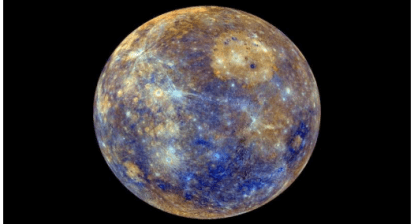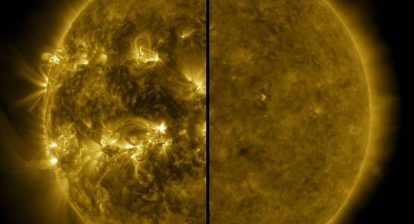Earth’s magnetic field is created by the motion of the convection currents of its fluid outer-core and this magnetic field extends outward like spaghetti. Its extent is known as the magnetosphere, reaching tens of thousands of kilometres into space – and it gives rise to our magnetic poles. The field envelops the Earth like a bubble and protects us from harmful solar winds, which blast us with the Sun’s radiation and particles. It also helps in navigation of course, and it may have even played a crucial role in the evolution of life.
(More about the Magnetosphere)
The changing conditions in space driven by the Sun are known as space weather and scientists have been studying magnetospheric waves to understand how solar activity impacts the space around Earth. Space weather can impact our communication satellites and even power lines on Earth.
Previously, scientists thought that magnetosperic waves (created by the interaction between the solar wind and the magnetosphere) travelling along the magnetosphere, would move in the direction of the solar wind. But a new study reveals that some waves do just the opposite. Some of the waves actually stand still. They studied surface waves, i.e the waves that require a boundary to travel along and this boundary is the edge of the magnetosphere.
The scientists observed the waves that form across the entire surface of the magnetosphere, using a combination of models and observations from NASA’s THEMIS mission, Time History of Events and Macroscale Interactions during Substorms. They found that when solar wind pulses strike, the waves that form not only race back and forth between Earth’s magnetic poles and the front of the magnetosphere, but also travel against the solar wind. Martin Archer, a space physicist at Imperial College London who led the new study, compared these two kinds of movement to crossing a river: “A boat can go from one riverbank to the other (traveling towards the poles) and upstream (against the solar wind). At the front of the magnetosphere, these waves appear to stand still.”
THEMIS observations from within the magnetosphere had already indicated previously that some waves might be travelling against the solar wind. This time the researchers used models to show how the energy of solar wind and the waves going against that wind could cancel each other out. “It’s similar to what happens if you try walking up a downwards escalator. It’s going to look like you’re not moving at all, even though you’re putting in loads of effort,” Archer said.
This work is important because standing waves may stick around longer than the ones that travel away with the solar wind, potentially impacting radiation belts, aurora or the ionosphere, by accelerating particles in near-Earth space. Furthermore, such standing waves may also occur elsewhere in the universe, like the magnetospheres of other planets or even the edges of black holes and studying them could help scientists understand the universe more.
More excitingly, we can listen to these standing waves by translating the wave models and data into the audible range. And here is that magnificant sound!







